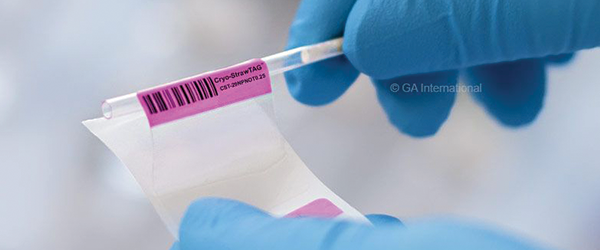
Labeling IVF cryo straws for long-term cryogenic storage
IVF straws are typically used to store eggs, sperm, and embryos, which undergo a process called vitrification. Vitrification is performed by rapidly freezing the cells in liquid nitrogen with the help of a cryoprotectant solution, usually composed of ethylene glycol, glycerol, or propylene glycol. As such, these straws require wrap-around labels with a strong cryo-adhesive to easily conform to the small diameter of the straws and to remain permanently attached during snap-freezing and cryogenic storage. Using the wrong type of label on vitrification straws will result in the label losing adhesion and slipping off the straw, as most adhesives do not stick well when exposed to vitrification or cryoprotectant solution. Given the importance of the information inscribed on the label, the ink used to print the labels should also not smudge or fade during cryogenic storage. The ideal solution to avoid these potential hazards requires using a cryogenic label specially designed for IVF vitrification straws alongside a thermal-transfer printer that uses a smudge and alcohol-proof resin ribbon, which will allow you to avoid accidental removal of the label and incidental smudging. Labels specially made for IVF procedures must also contain relatively low levels of VOCs; however, the exact limit varies depending on the testing standards of the lab using them.
The repercussions of improper labeling
Inflating costs – With costs of collecting eggs as high as $10,000 with an additional $460 per year to store them, IVF laboratories can ill afford to have any errors or mishaps. A mislabeled specimen or a sample that loses its identifying information can require them to recollect samples at their own cost while exposing them to legal ramifications. They might also suffer a largely tarnished reputation, harming their future earnings potential.
Identification errors – Improper labeling of sperm, eggs, or embryos can result in the wrong sperm being used to inseminate a woman, the wrong combination of sperm and/or eggs being fertilized, or the transfer of the wrong embryo into the wrong uterus. Babies can be born with different genetic lineages than the parents’—sometimes they are not related to the parents at all—because of a small lab error. Using an electronic witnessing system (EWS) with either radio-frequency identification (RFID) or barcode labels can help prevent these sorts of errors from occurring, as technicians will have to scan the label at every step of the procedure, allowing the sample to be tracked efficiently and ensuring that the information isn’t misread. The added traceability also helps safeguard against using the wrong sperm or egg samples to produce embryos. For systems that incorporate RFID labels, merely placing two samples (like an egg and sperm) from mismatched donors will alert the EWS that an error is about to occur and will halt the procedure. Here, reputation is key as no clinic wants to be associated with labeling errors that result in babies who have an entirely different genetic lineage than the parents.
In IVF clinics, it is of critical importance to use only properly tested and certified labels that are guaranteed to stay attached to sample straws throughout the vitrification process and during long-term storage in cryogenic tanks. The right labeling solution is paramount to ensuring your ART clinic runs smoothly and error-free, with clients depending on the clinic to get it right in as few tries as possible, as they’re always looking to mitigate the growing costs and extreme stresses of undergoing procedures like IVF.
LabTAG by GA International is a leading manufacturer of high-performance specialty labels and a supplier of identification solutions used in research and medical labs as well as healthcare institutions.